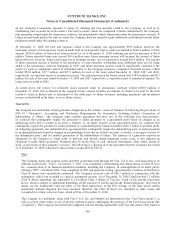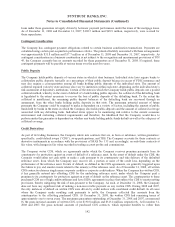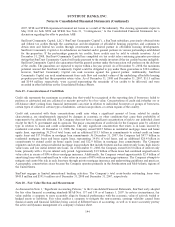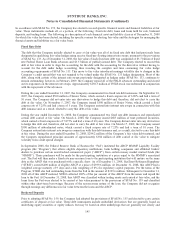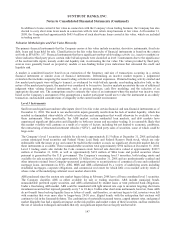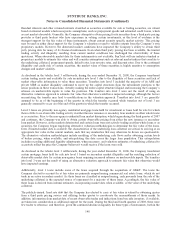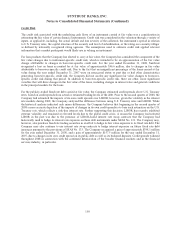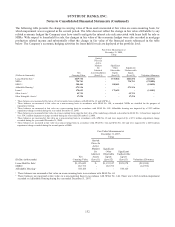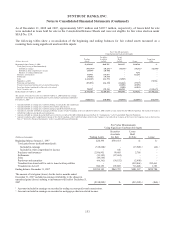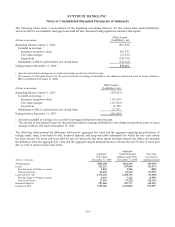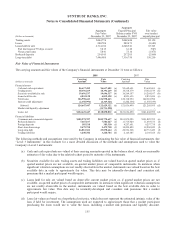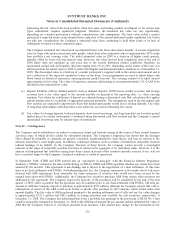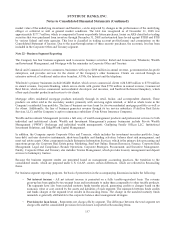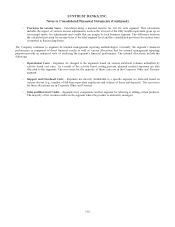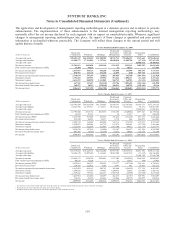SunTrust 2008 Annual Report Download - page 161
Download and view the complete annual report
Please find page 161 of the 2008 SunTrust annual report below. You can navigate through the pages in the report by either clicking on the pages listed below, or by using the keyword search tool below to find specific information within the annual report.SUNTRUST BANKS, INC.
Notes to Consolidated Financial Statements (Continued)
secondary markets and for primary issuances, this debt was transferred from a level 2 to a level 3 classification in the
fair value hierarchy effective July 1, 2008. The transfer into level 3 was not the result of using an alternative valuation
approach to estimate fair value that otherwise would have impacted earnings.
Beginning in the first quarter of 2008, the Company classified IRLCs on residential mortgage loans held for sale, which
are derivatives under SFAS No. 133, on a gross basis within other liabilities or other assets. The fair value of these
commitments, while based on interest rates observable in the market, is highly dependent on the ultimate closing of the
loans. These “pull-through” rates are based on the Company’s historical data and reflect the Company’s best estimate of
the likelihood that a commitment will ultimately result in a closed loan. As a result of the adoption of SAB No. 109,
beginning in the first quarter of 2008, servicing value was also included in the fair value of IRLCs.
The fair value of MSRs is determined by projecting cash flows which are then discounted to estimate an expected fair
value. The fair value of MSRs is impacted by a variety of factors, including prepayment assumptions, discount rates,
delinquency rates, contractually specified servicing fees, and underlying portfolio characteristics. The underlying
assumptions and estimated values are corroborated by values received from independent third parties based on their
review of the servicing portfolio. Because these inputs are not transparent in market trades, MSRs are considered to be
level 3 assets in the valuation hierarchy. As of December 31, 2008, the Company recognized an MSR valuation
allowance in the amount of $370.0 million as a result of impairment. As of December 31, 2007, no MSR valuation
allowance was recognized as a result of impairment.
Derivative instruments are primarily transacted in the institutional dealer market and priced with observable market
assumptions at a mid-market valuation point, with appropriate valuation adjustments for liquidity and credit risk. For
purposes of valuation adjustments to its derivative positions under SFAS No. 157, the Company has evaluated liquidity
premiums that may be demanded by market participants, as well as the credit risk of its counterparties and its own
credit. The Company has considered factors such as the likelihood of default by itself and its counterparties, its net
exposures, and remaining maturities in determining the appropriate fair value adjustments to record. Generally, the
expected loss of each counterparty is estimated using the Company’s proprietary internal risk rating system. The risk
rating systems utilize counterparty specific probabilities of default and loss given default estimates to derive the
expected loss. For counterparties that are rated by national rating agencies, those ratings are also considered in
estimating the credit risk. In addition, counterparty exposure is evaluated by netting positions that are subject to master
netting arrangements, as well as considering the amount of marketable collateral securing the position. Specifically
approved counterparties and exposure limits are defined. The approved counterparties are regularly reviewed, and
appropriate business action is taken to adjust the exposure to certain counterparties, as necessary. This approach used to
estimate impacted exposures to counterparties is also used by the Company to estimate its own credit risk on derivative
liability positions. To date, no material losses due to a counterparty’s inability to pay any net uncollateralized position
has been incurred. The Company adjusted the net fair value of its derivative contracts for estimates of net counterparty
credit risk by approximately $23.1 million and $6.9 million as of December 31, 2008 and 2007, respectively.
Most derivative instruments are level 1 or level 2 instruments, except for the IRLCs discussed herein. In addition, the
equity forward agreements (the “Agreements”) the Company entered into related to its Coke stock are level 3
instruments within the fair value hierarchy of SFAS No. 157, due to the unobservability of a significant assumption used
to value these instruments. Because the value is primarily driven by the embedded equity collars on the Coke shares, a
Black-Scholes model is the appropriate valuation model. Most of the assumptions are directly observable from the
market, such as the per share market price of Coke, interest rates, and the dividend rate on Coke. Volatility is a
significant assumption and is impacted both by the unusually large size of the trade and the long tenor until settlement.
Because the derivatives carry initial terms of approximately six and a half and seven years and are on a significant
number of Coke shares, the observable and active options market on Coke does not provide for any identical or similar
instruments. As such, the Company receives estimated market values from a market participant who is knowledgeable
about Coke equity derivatives and is active in the market. Based on inquiries of the market participant as to their
procedures as well as the Company’s own valuation assessment procedures, the Company has satisfied itself that the
market participant is using methodologies and assumptions that other market participants would use in arriving at the
fair value of the Agreements. At December 31, 2008, the Agreements’ fair value represented an asset position for the
Company of approximately $249.5 million.
Certain level 3 assets include non-financial assets such as affordable housing properties, private equity investments, and
intangible assets that are measured on a non-recurring basis based on third party price indications or the estimated
expected remaining cash flows to be received from these assets discounted at a market rate that is commensurate with
their risk profile.
149



